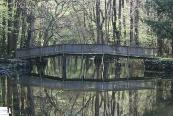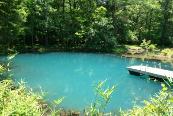
Blue Hole: A Florida Spring
The Blue Hole is a natural
Florida spring. The water
rises from underground.
The Blue Hole is a natural
Florida spring. The water
rises from underground.
Interpretive Kiosk
Visitors learn about the spring
and how it was formed from
this informational panel by the
walkway leading to the water.
Visitors learn about the spring
and how it was formed from
this informational panel by the
walkway leading to the water.
Blue Hole Spring at Florida Caverns State Park - Marianna, Florida
Blue Hole Spring at Florida Caverns State Park
| The Blue Hole at Florida Caverns The Blue Hole, seen here on a cool, quiet day, is popular for swimming and picnicking. |
Water that will turn you blue!
Blue Hole Spring is a landmark of Florida
Caverns State Park in Marianna, Florida. Its
cold, clear waters are among the sources of
the pristine Chipola River.
According to local folklore, the name
originates because the spring is a "hole filled
with water so cold it will turn you blue!" It is
also possible that the name originated from
the beautiful blue color often displayed by the
water on sunny days.
Either way, Blue Hole is all natural and is
enjoyed by visitors to Florida Caverns who
come to enjoy swimming, sunbathing,
picnicking and the beautiful view.
In addition to its natural significance, the
spring is an important historical landmark.
Spanish missionaries and soldiers crossed
the nearby Natural Bridge of the Chipola and
passed by Blue Hole in June of 1674. They
were on their way to establish Mission San
Carlos and Mission San Nicolas west of the
park.
Andrew Jackson's U.S. Army passed here in
1818 during the First Seminole War and
Jackson's topographer, Captain Hugh
Young, made note of the spring, although he
incorrectly believed that it was the rise of the
Chipola River.
The spring was an important landmark for
early settlers and a primary road leading
west through Jackson County passed by
Blue Hole until better routes were built north
and south of the park in the 1820s.
Blue Hole then became a popular recreation
spot for the citizens of the Marianna area.
Numerous accounts from the first half of the
19th century mention picnics and outdoor
gatherings at the spring.
During the Reconstruction era, however, a
major incident of violence took place at Blue
Hole Spring. Exactly what happened is not
clear to this day, but eyewitnesses claimed
that a gunshot rang out as a party of African
Americans was on its way to the spring for a
picnic.
The incident took place on September 28,
1869, and ended with the death of a young
child. Some claimed that a shot had been
fired from the woods, but others believed the
shooting had been an "inside job."
The truth may never be known, but the
incident ignited a frenzy of violence. Over the
days and weeks that followed, shootings and
reprisals left numerous people dead and
wounded in Marianna and Jackson County.
The tensions eventually subsided, but the
"Picnic Shooting" was a major incident of the
Reconstruction era in Florida. Its memory
remains an important part of the history of
Blue Hole Spring.
Caverns State Park in Marianna, Florida. Its
cold, clear waters are among the sources of
the pristine Chipola River.
According to local folklore, the name
originates because the spring is a "hole filled
with water so cold it will turn you blue!" It is
also possible that the name originated from
the beautiful blue color often displayed by the
water on sunny days.
Either way, Blue Hole is all natural and is
enjoyed by visitors to Florida Caverns who
come to enjoy swimming, sunbathing,
picnicking and the beautiful view.
In addition to its natural significance, the
spring is an important historical landmark.
Spanish missionaries and soldiers crossed
the nearby Natural Bridge of the Chipola and
passed by Blue Hole in June of 1674. They
were on their way to establish Mission San
Carlos and Mission San Nicolas west of the
park.
Andrew Jackson's U.S. Army passed here in
1818 during the First Seminole War and
Jackson's topographer, Captain Hugh
Young, made note of the spring, although he
incorrectly believed that it was the rise of the
Chipola River.
The spring was an important landmark for
early settlers and a primary road leading
west through Jackson County passed by
Blue Hole until better routes were built north
and south of the park in the 1820s.
Blue Hole then became a popular recreation
spot for the citizens of the Marianna area.
Numerous accounts from the first half of the
19th century mention picnics and outdoor
gatherings at the spring.
During the Reconstruction era, however, a
major incident of violence took place at Blue
Hole Spring. Exactly what happened is not
clear to this day, but eyewitnesses claimed
that a gunshot rang out as a party of African
Americans was on its way to the spring for a
picnic.
The incident took place on September 28,
1869, and ended with the death of a young
child. Some claimed that a shot had been
fired from the woods, but others believed the
shooting had been an "inside job."
The truth may never be known, but the
incident ignited a frenzy of violence. Over the
days and weeks that followed, shootings and
reprisals left numerous people dead and
wounded in Marianna and Jackson County.
The tensions eventually subsided, but the
"Picnic Shooting" was a major incident of the
Reconstruction era in Florida. Its memory
remains an important part of the history of
Blue Hole Spring.
Swimming with the Alligators
This sign at Blue Hole
reminds visitors that they
share the spring with
Florida's wildlife, including
alligators.
This sign at Blue Hole
reminds visitors that they
share the spring with
Florida's wildlife, including
alligators.
In the 20th century, Blue Hole Spring was
included in Florida Caverns State Park and
developed for use as a swimming and picnic
area. Changes in the natural water flow
caused the water to become cloudy and it
was restored to its natural state a few years
ago.
The spring is a fascinating place to learn
about the karst topography of Florida. The
water that feeds it passes through passages
in limestone and the clarity and color of the
Blue Hole can change dramatically in a
matter of hours due to rises and falls of the
Chipola River.
When the water is clear, the spring is open
for swimming. The grounds, however,
remain open throughout the year. A floating
dock, boardwalk and interpretive kiosk have
been added to help visitors access and enjoy
the banks of the Blue Hole.
According the Northwest Florida Water
Management District, the water emerges
from the spring with a temperature of 67.8
degrees (quite warm in the winter and quite
cold in the summer). It comes from a natural
vent that is 38.5 feet below the surface. Read
their report by clicking here.
Picnic areas and restroom facilities are
available at Blue Hole. Florida Caverns State
Park is open 365 days per year.
Click here to visit the park's official website
for more information.
included in Florida Caverns State Park and
developed for use as a swimming and picnic
area. Changes in the natural water flow
caused the water to become cloudy and it
was restored to its natural state a few years
ago.
The spring is a fascinating place to learn
about the karst topography of Florida. The
water that feeds it passes through passages
in limestone and the clarity and color of the
Blue Hole can change dramatically in a
matter of hours due to rises and falls of the
Chipola River.
When the water is clear, the spring is open
for swimming. The grounds, however,
remain open throughout the year. A floating
dock, boardwalk and interpretive kiosk have
been added to help visitors access and enjoy
the banks of the Blue Hole.
According the Northwest Florida Water
Management District, the water emerges
from the spring with a temperature of 67.8
degrees (quite warm in the winter and quite
cold in the summer). It comes from a natural
vent that is 38.5 feet below the surface. Read
their report by clicking here.
Picnic areas and restroom facilities are
available at Blue Hole. Florida Caverns State
Park is open 365 days per year.
Click here to visit the park's official website
for more information.




Swimming with the Alligators
This sign at Blue Hole
reminds visitors that they
share the spring with
Florida's wildlife, including
alligators.
This sign at Blue Hole
reminds visitors that they
share the spring with
Florida's wildlife, including
alligators.
Florida Caverns State Park
Jackson County Spanish Heritage Trail
Battle of Marianna
Marianna, Florida
Historic Sites & Points of Interest
Historic Sites in Florida
Springs & Waterfalls of Florida
The Outdoors & Eco-Tourism in the South
Explore other Southern Historic Sites
Jackson County Spanish Heritage Trail
Battle of Marianna
Marianna, Florida
Historic Sites & Points of Interest
Historic Sites in Florida
Springs & Waterfalls of Florida
The Outdoors & Eco-Tourism in the South
Explore other Southern Historic Sites
Blue Hole Spring at Ichetucknee
Blue Springs Recreational Area (Marianna)
Homosassa Springs Wildlife State Park
Ichetucknee Springs State Park
Juniper Springs Recreation Area
Ponce de Leon Springs State Park
Rainbow Springs State Park
Silver Springs State Park
Wakulla Springs State Park
Blue Springs Recreational Area (Marianna)
Homosassa Springs Wildlife State Park
Ichetucknee Springs State Park
Juniper Springs Recreation Area
Ponce de Leon Springs State Park
Rainbow Springs State Park
Silver Springs State Park
Wakulla Springs State Park
Natural Springs in Florida
| Copyright 2011 & 2014 by Dale Cox All rights reserved. Last Updated: March 24, 2014 |

Custom Search

